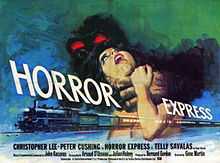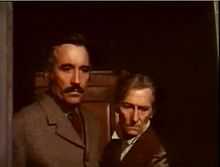Horror Express
| Horror Express | |
|---|---|
 Film poster | |
| Directed by | Eugenio Martín |
| Produced by |
Bernard Gordon Gregorio Sacristan |
| Written by |
Arnaud d'Usseau Julian Zimet (as Julian Halevy) |
| Based on |
Who Goes There? (1938) by John W. Campbell, Jr. |
| Starring |
Christopher Lee Peter Cushing Telly Savalas Alberto de Mendoza Helga Line George Rigaud Víctor Israel |
| Music by | John Cacavas |
| Cinematography | Alejando Ulloa |
| Edited by | Robert C. Dearberg |
Release dates | October 1972 (Spain) |
Running time | 90 min. |
| Country |
United Kingdom Spain |
| Language | English |
| Budget | $300,000 |
Horror Express, also known as Pánico en el Transiberiano/Panic on the Trans-Siberian Express, is a 1972 Spanish/British horror film directed by Eugenio Martín and starring Christopher Lee, Peter Cushing, Alberto de Mendoza and Telly Savalas. It was produced by Bernard Gordon and written by Arnaud d'Usseau and Julian Zimet (credited as Julian Halevy). The film is based on the 1938 novella "Who Goes There?" by John W. Campbell (writing under the pseudonym of Don A. Stuart).[1]
Storyline
Prologue

The story opens with Saxton narrating;
"The following report to the Royal Geological Society by the undersigned Alexander Saxton is a true and faithful account of the events that befell the society's expedition in Manchuria. As the leader of the expedition, I must accept the responsibility for its ending in disaster. But I will leave, to the judgement of the honorable members, the decision as to where the blame for the catastrophe lies..."
Plot
In 1906, Professor Alexander Saxton (Christopher Lee), a renowned British anthropologist, is returning to Europe by the Trans-Siberian Express from China to Moscow. With him is a crate containing the frozen remains of a primitive humanoid creature that he discovered in a cave in Manchuria. He hopes it is a missing link in human evolution. Doctor Wells (Peter Cushing), Saxton's friendly rival and Royal Society colleague, is also on-board but travelling separately. Before the train departs Shanghai, a thief is found dead on the platform. His eyes are completely white without irises or pupils, and a bystander initially mistakes him for a blind man. A monk named Father Pujardov (Alberto de Mendoza), the spiritual advisor to a Polish Count and Countess who are also waiting to board the train, proclaims the contents of the crate to be evil. Saxton furiously dismisses this as superstition. Saxton's eagerness to keep his scientific find secret arouses the suspicion of Wells, who bribes a porter to investigate the crate. The porter is killed by the ape-like creature within, which then escapes the crate by picking the lock.
The creature finds more victims as it roams the moving train, each victim being found with the same opaque, white eyes. An autopsy suggests that the brains of the victims are being drained of memories and knowledge. When the creature is gunned down by police Inspector Mirov, the threat seems to have been vanquished. Saxton and Wells discover that images are retained in a liquid found inside the eyeball of the corpse, which reveal a prehistoric Earth and a view of the planet seen from space. They deduce that the real threat is somehow a formless extraterrestrial that inhabited the body of the creature and now resides within the Inspector. Father Pujardov, sensing the greater presence inside the Inspector and believing it to be that of Satan, renounces his faith to pledge allegiance to the mysterious entity.
News of the murders is wired to the Russian authorities. An intimidating Cossack officer, Captain Kazan (Telly Savalas), boards the train with a handful of his men. Kazan believes the train is transporting rebels; he is only convinced of the alien's existence when Saxton switches off the lights and Mirov's eyes glow, revealing him to be the creature's host. The creature has absorbed the memories of Wells' assistant, an engineer, and others. It seeks the Polish Count's metallurgical knowledge too, in order to build a vessel to escape Earth. Kazan fatally shoots Mirov, and the alien transfers itself to the deranged Pujardov.
The passengers flee to the freight car while Pujardov murders Kazan, his men, and the Count, draining all of their minds. Saxton rescues the Countess and holds Pujardov at gunpoint. Saxton, having discovered that bright light prevents the entity from draining minds or transferring to another body, forces Pujardov into a brightly lit area. The creature/Pujardov explains that it is a collective form of energy from another galaxy. Trapped on Earth in the distant past after being left behind in an accident, it survived for millions of years in the bodies of protozoa, fish and other animals, but cannot live outside a living being longer than a few moments. The creature begs to be spared, tempting Saxton with its advanced knowledge of technology and cures for diseases. While Saxton is distracted by the offer, the creature resurrects the Count's corpse which attacks Saxton.
Saxton and the Countess flee the creature, but it now resurrects all of its victims as zombies. Battling their way through the train, Saxton and the Countess eventually reach the caboose where the other survivors have taken refuge. Once there, Saxton and Wells work desperately to uncouple themselves from the rest of the train. The Russian government sends a telegram to a dispatch station ahead, instructing them to destroy the train by sending it down a dead-end spur. Speculating that it must be war, the station staff switch the points.
The creature takes control of the train as it enters the spur. Saxton and Wells manage to separate the last car from the rest of the train. The creature tries to find the brakes to try and stop the train, but fails to even get it to slow down as it rams through the barrier and plunges down the cliff, destroying it as soon as it hits the bottom. The caboose rolls precariously to the end of the track before stopping, inches away from the edge of the cliff. The survivors quickly depart from the caboose while Saxton, Wells and the Countess gaze over the ravine to witness the inferno consuming the train and its unearthly inhabitants.
Cast
- Christopher Lee ... Professor Sir Alexander Saxton
- Peter Cushing ... Dr. Wells
- Alberto de Mendoza ... Father Pujardov
- Telly Savalas ... Captain Kazan
- Julio Peña ... Inspector Mirov
- Silvia Tortosa ... Countess Irina Petrovski
- Ángel del Pozo ... Yevtushenko
- Helga Liné ... Natasha
- Alice Reinhear ... Miss Jones
- José Jaspe ... Conductor Konev
- George Rigaud ... Count Marion Petrovski
- Víctor Israel ... Maletero – the Baggage Man
- Faith Clift ... American Passenger (credited as Faith Swift)
- Juan Olaguivel ... the Creature (credited as Juan Olaguibel)
- Barta Barri ... First Telegraphist
Production
Horror Express was filmed in Madrid between 1971 and 1972, produced on a low budget of $300,000 with the luxury of having three familiar genre actors in the lead. The film was co-produced by American screenwriter/producer Bernard Gordon, who had collaborated with Martin on the 1972 film Pancho Villa (which featured Savalas in the title role). Though it was believed that as Bernard Gordon had acquired the train model used in Nicholas and Alexandra and he commissioned a script for its use,[2] Gordon denied it, saying the model had been constructed for Pancho Villa.[3] Filmmakers used the mock-up from Pancho Villa as the interior for all train cars during production since no further room was available on stage. All scenes within each train car were shot consecutively, the set then modified and shot for the next car.[4]
The film had the train station sequences shot at the 1880 Railway Museum (Madrid) designed by Gustave Eiffel.
Securing Lee and Cushing was a coup for Gordon, since it lent a certain atmosphere reminiscent of Hammer Films, many of which starred both of the actors. However, when Cushing arrived in Madrid to begin work on the picture, he was still distraught over the recent death of his wife, and announced to Gordon that he could not do the film. With Gordon desperate over the idea of losing one of his important stars, Lee stepped in and put Cushing at ease simply by talking to his old friend about some of their previous work together. Cushing changed his mind and stayed on.[4]
Like all the Italian and Spanish films of the period, Horror Express was filmed mostly without sound, with effects and voices dubbed into the film later. Lee, Cushing and Savalas all provided their own voices for the English market.[5]
Release and reception
The film generally received mixed reviews, with a Rotten Tomatoes approval rating of 57%.
This film was first titled Pánico en el Transiberiano and first released as an officially selected film of 1972 Sitges Film Festival.[6] Eugenio Martín won Critic's Award Best Script for this film.[7]
According to director Eugenio Martín, his native country of Spain was where the film fared worst, both critically and in terms of box office revenue.[5] The film was received more positively in other markets where the audience was more familiar with low-budget horror films, such as Great Britain, the United States and Australia.
A special edition Blu-ray/DVD release of the film was issued in 2011 by Severin Films.[8][9][10]
See also
- List of films in the public domain
References
- ↑ Warren, Bill. Keep Watching The Skies Vol I: 1950 - 1957, pgs. 151 - 163, McFarland, 1982. ISBN 0-89950-032-3.
- ↑ Fangoria magazine, Lukeman, Adam & Timpone, Anthony editor Fangoria's 101 Best Horror Movies You've Never Seen: A Celebration of the World's Most Unheralded Fright Flicks Three Rivers Press, 2003
- ↑ http://www.mania.com/hollywood-exile-bernard-gordon-scifis-secret-screenwriter_article_21762.html
- ↑ 4.0 4.1 Bernard Gordon interview, mania.com; last accessed May 26, 2010
- ↑ 5.0 5.1 Liner notes, Horror Express DVD release by Image Entertainment, written by Mark Walkow.
- ↑ "5ed. Semana Internacional de cine Fantástico y de Terror (30/9–6/10): Films." Sitges Film Festival, 1972. Web. 29 January 2012 <http://sitgesfilmfestival.com/eng/arxiu/1972/programacio#01>.
- ↑ "5ed. Semana Internacional de cine Fantástico y de Terror (30/9–6/10): Awards 1972." Sitges Film Festival, 1972. Web. 29 January 2012 <http://sitgesfilmfestival.com/eng/arxiu/1972/palmares#01>.
- ↑ British Horror Coming on Strong on DVD and Blu-ray
- ↑ http://www.severin-films.com/2011/11/22/horror-express/
- ↑ http://www.dvdbeaver.com/film3/blu-ray_reviews55/horror_express_blu-ray.htm
Notes
- Gallman, Brett (3 November 2011). Review of Horror Express at Oh, the Horror! Retrieved 24 March 2012.
- Tyner, Adam (13 November 2011). Review of Horror Express (Blu-ray) at DVDTalk.com. Retrieved on 24 March 2012.
- Review of Horror Express at Mondo-digital.com. 25 October 2011. Retrieved on 2 January 2012.
External links
| Wikiquote has quotations related to: Horror Express |
| Wikimedia Commons has media related to Horror Express (film). |
- Horror Express at the Internet Movie Database
- Horror Express on YouTube
- Horror Express at AllMovie
- Copyright Catalog at Library of Congress; select "Document Number", type "V8008P295", and press Enter